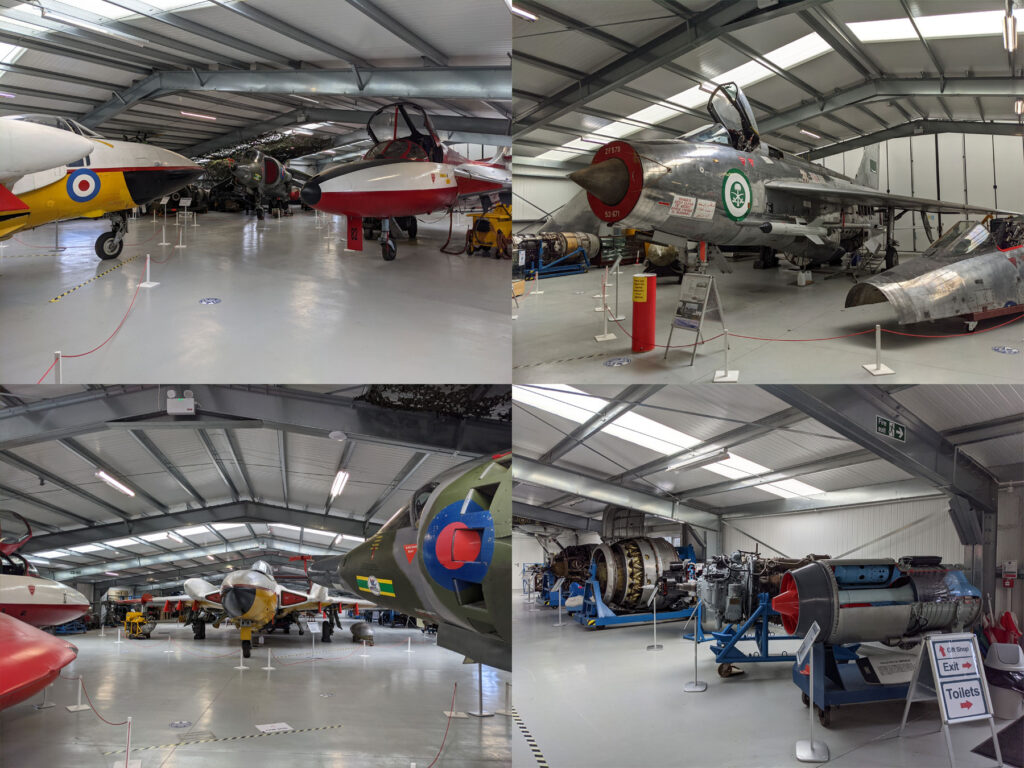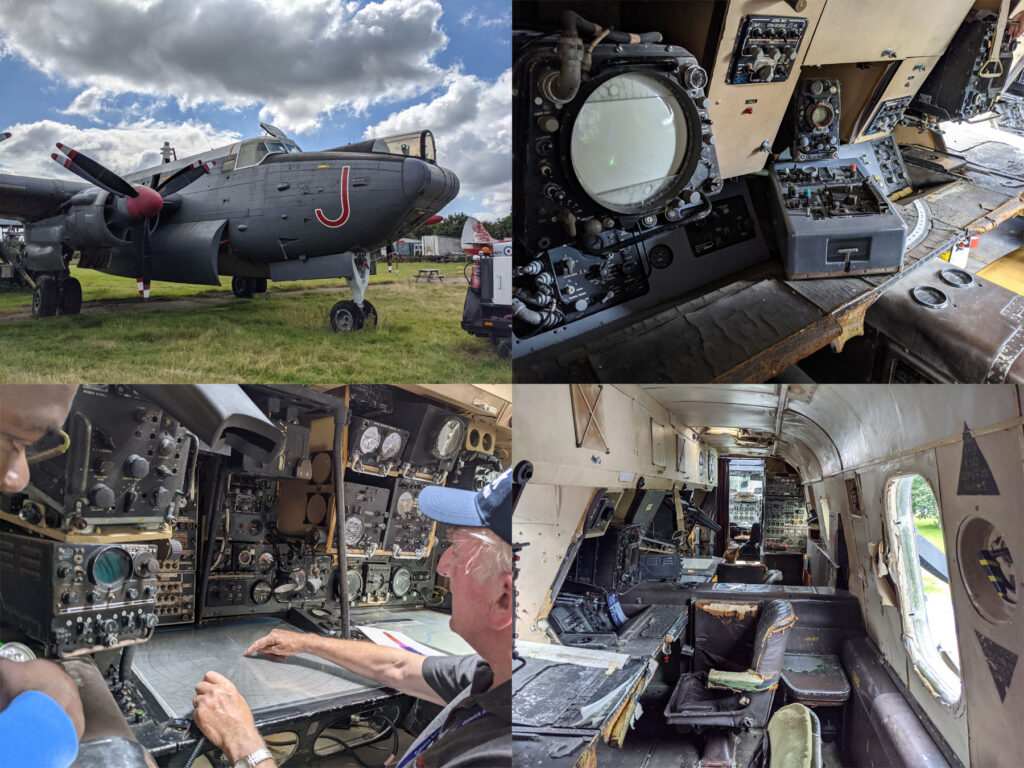On the far side of Gatwick Airport is a museum, partly about the airport, but mainly about the military side of aviation.
It’s on a side road in an area that apart from the occasional roar of a plane taking off could well be a rural countryside retreat. The first thing you notice when walking down the drive to the entrance is the smell – not of planes and oil, but cow dung. We’re on a farm, and the collection here was originally started by the farmer who bought planes and kept them in the fields before the part of the farm became a museum.
Also, ignore the mock-Tudor cottage and head around the corner to the large shed with a way-in sign, and someone will take you into the main display and depending on your areas of interest give an introduction to the museum and you’re free to wander around.
This is a museum that can be looked at as somewhere to visit objects you want to study up close, or one to soak up a bit of atmosphere, of oil and leather, and of a Mr Cholmondeley-Warner(esqe) narration from a video playing in the background.
A recent delivery is a Virgin Atlantic cabin simulator which is currently being set up and will shortly let you take a simulated flight in a first-class cabin. Not on my visit though, they’re still wiring it up.
One thing that is very different to most aircraft museums I’ve visited is that the signage there will be about the planes, but here it’s mainly about the engines. Each plane on display has its engine sitting next to it, and a sign explaining the engine. That gives the display a different feel to it, in a good way, as it’s not often that the engines for planes sit next to the planes they powered.
Elsewhere, there’s a row of engines in the shed, and one huge one outside the shed. One of the stand-alone engines looks like it came from a Concorde, and the model of Concorde next to it reinforces that, but they recently found it actually came from the earlier cancelled TSR-2 cold war attack plane.
Lots of glass cases are dotted around filled with bits of instruments, models, helmets, and next to the Harrier, pieces from one that was shot-down during the Falklands War. Outside are a few more aircraft, and there’s a display in another shed about the history of Gatwick Airport.
If that’s all there is, it’s a decently good museum.
But there’s something else.
Outside is an Avro Shackleton, and inside it is a man who used to be a navigator on board, and will give you a very good 30-40 minute chat about what they used to do when these planes were out on patrol watching for enemies.
Like most military vehicles, it’s function over comfort and humans are squashed in wherever there’s a gap between the equipment. A couple of bunk beds to rest on during the often 15-hour missions turned out to be much more use to store food than humans, and the crew also had to bring their own plates and cutlery. A miniature galley could serve up classic English stodgy food which is remarkably satisfying when flying in a poorly insulated plane.
It was an unreliable plane by many counts, and considering it was named after an Antarctic explorer had an awkward tendency for the tailplanes to ice up at times. So long as you don’t mind climbing over bulkheads and through cramped gaps, the tour spends most of the time going into a lot of detail about the missions and how they would track enemy submarines.
Such was the intensity of concentration needed to watch their radars and listen for the enemy radar that they would swap seats around every 20-minutes or so to give people a break. A good explanation about how they could pinpoint targets using triangulation, a pencil and a ruler all in real-time to track the submarines based on sonar echos. The plane was equipped with sonars to drop for tracking, and torpedoes should they ever go into conflict.
And nuclear bombs.
Not the massive bombs of cold-war terror, but small tactical depth bombs that if dropped close enough were capable of sinking the Russian heavy strengthened submarines. As he explained, given the choice between dropping a nuclear bomb that will kill 100 submariners under the ocean, vs letting that submarine launch several dozen warheads at civilian cities, it’s not a difficult decision to take.
He was a bit evasive about the specifications of the bombs, but that information is online these days.
You can squeeze your way forward to the pilot’s seats, and if you manage to avoid hitting your head down into the forward gunner point, or pose for a photo in the pilot’s seat.
A visit is partly a fascinating view inside a once top-secret interior of a plane where even inside the crew of a dozen or so may not have been able to tell colleagues what they knew about specific missions. It’s also a sobering reminder of how uncomfortable life was for people who were out there seeking to protect the country from attack, and the privations they struggled with on those long missions.
I expected to spend maybe an hour there, my visit was at least double that and could have stretched to 3+ hours if you spend longer reading signs and peering at glass cases.
The Gatwick Aviation Museum is currently open Fri, Sat and Sun, and they prefer to have tickets bought online first as they don’t accept cards in the museum, cash only. The museum also occasionally powers up a couple of their engines, contact them for details as to when that might next happen.
Getting to the Gatwick Aviation Museum
The downside to the museum is that it’s not convenient to get to. There is an occasional bus on Friday to the nearby village of Charlwood from Dorking and Gatwick Airport station. If visiting at weekends though, you’re either walking, cycling or driving to get there.
The address is Lowfield Heath Road, Charlwood, Surrey, RH6 0BT
If walking, I would recommend going around the northern side of Gatwick Airport as the main roads had pavements along most of the route. A weekend bus (route 100) will get you about a quarter of the way, but no further.
Then again, getting to a difficult to get to museum is a reward in itself.
At the museum, the nearby village of Charlwood has a pub, a cafe and a very old church that’s also worth visiting.









Can you walk out of Gatwick Airport? You cant at Heathrow I discovered the hard way….
I certainly walked out of Gatwick Aiport without any hassles.
You can also walk in/out of Heathrow Terminal 4 at least, not tried T5, although sadly T1-T3 is no longer walkable.
I don’t think that the authorities expect perimeter pedestrians and you might have been doubly lucky Ian. Admittedly a few years ago, I had missed my flight by two minutes at Stansted (points failure at one of the little used King’s Cross “curves”). So I went for a wander until the next flight and forty minutes later was picked up by the airport rozzers next to a car park, grilled quite thoroughly but then driven all the way back to the terminal. Maybe I was unlucky.
At Gatwick at least, there’s a dedicated cycle path and plenty of pedestrian route signs along the outside of the airport buildings – so luck was not involved.
On the wide bridge between the railway station and the airport There is – or was about 10 years ago – a doorway at the top of stairs leading to the roadway below. Handy for getting the bike down and onto the road that runs between the railway and airport, outside the perimeter.
Perhaps someone can advise if that route is still there?
There are regular (Mon-Sat) bus services (routes 21/22) that run between Crawley and Dorking via Charlwood, some of which (route 22) call at Gatwick Airport.
Interesting article about your visit & delighted you enjoyed Nev’s talk about the Shackleton. As another ex Shack aircrewman (Air Electronics 2500 hours flying time & high tone deaf as a result!) I’ve known Nev for a number of years. I discovered the existence of the Museum through a contact with him about Nimrods and have subsequently become a museum member. I intend to visit shortly so may eventually help on weekend Open days to talk about the Air Electronics roles
Please amend the incorrect information. The man who started the museum was NOT a farmer and the Olympus 320 has been known as a TSR2 engine since it arrived. It’s inaccuracies like this that get repeated and start to acquire the element of fact. By the way the Cottage is 16th Century, removed from Gatwick when the new airport was built and re-assembled in its current location.
As both statements about the museum were delivered to me by a member of staff at the museum, so please direct your ire at them, and if stating that something is wrong, it helps to provide the evidence of that.
I knew Peter Vallance for 25+ years and was a volunteer on the engineering team (Ex RAF) and trustee at the museum until May this year. I left after disagreeing with the “new” direction that the other trustees wanted to take the museum in. As I feared the museums standards have fallen to a point where mis-information is now being offered as fact. Clearly the staff member was not in posession of the museums history, sadly a clear failure of the museums to educate their staff. I hasn’t helped that a number of very well informed staff have left.
Card payments: the museum most certainly DOES accept card payments, so there’s no need to bring cash (unless you really want to!). So please disregard the comment regarding this on the original post.
And we also accept pre-booking if you prefer:
https://www.gamc.org.uk/tickets